GEAB 174
2023 – From dollar shortage to a multi-directional financial crisis… until better times are coming
In support of our urgent recommendation to diversify in the face of a major financial shock, here is a brief description of the systemic phenomena at work behind the byzantine analyses of the current crisis. It does not give cause for optimism, even if we show that the shock in question is the result of a much-needed transition. This analysis will be followed by some strategic recommendations to survive the hit.
Inflation does not only hurt households. It attacks the entire economic and banking edifice right to the top, namely the central banks, which are emptying themselves of their currencies to support their own currencies and avoid the hyperinflation spiral. Meanwhile, the Fed has turned off the printing machine with the same aim of supporting the value of the dollar, favouring of course its own population – the most indebted in the world (94,000 USD per person).[1]
At the moment, central banks in fragile countries are suffering. We have identified the major difficulties faced by Kenya,[2] Bolivia[3] for example, but the list is long, and those countries are facing a drying up of their foreign exchange reserves.[4]
The problem is the dependence on the national currency of a single country, the United States, which has gradually become unable to provide the huge multipolar economy with the liquidity it needs to pay for its international trade. It is no coincidence that a former Goldman Sachs executive is encouraging the BRICS to launch their own currency.[5]
The current crisis is the global version of the “dollar gap” at the end of WW2, a physical shortage of dollars. At that time, the war brought European production to a standstill and forced Europeans to buy arms from the US in dollars. At the end of the war, Europe did not have a dollar left to buy from the Americans the products only the US produced, demanding to be paid in their currency. This is the “dollar gap“.[6]
Login

For 17 years, the GEAB has been characterising one by one the phases of the global systemic transition process. As of April 2023, it is very clear that the "new [...]
For almost 20 years we have been anticipating a revolution in the international monetary system and in particular the emancipation of the global economy from the trade vehicle of the [...]
Climate change has been shifting our relationship with water, bringing power and politics into human rights issues of access and management, because the powerless is particularly hit by this. Besides [...]
Bogdan Herea, founder and CEO of PitechPlus (a full-cycle software development company) and founder of Academy+Plus (a Romanian Ecole 42), is what some call the "Romanian Xavier Niel" . His [...]

Comments